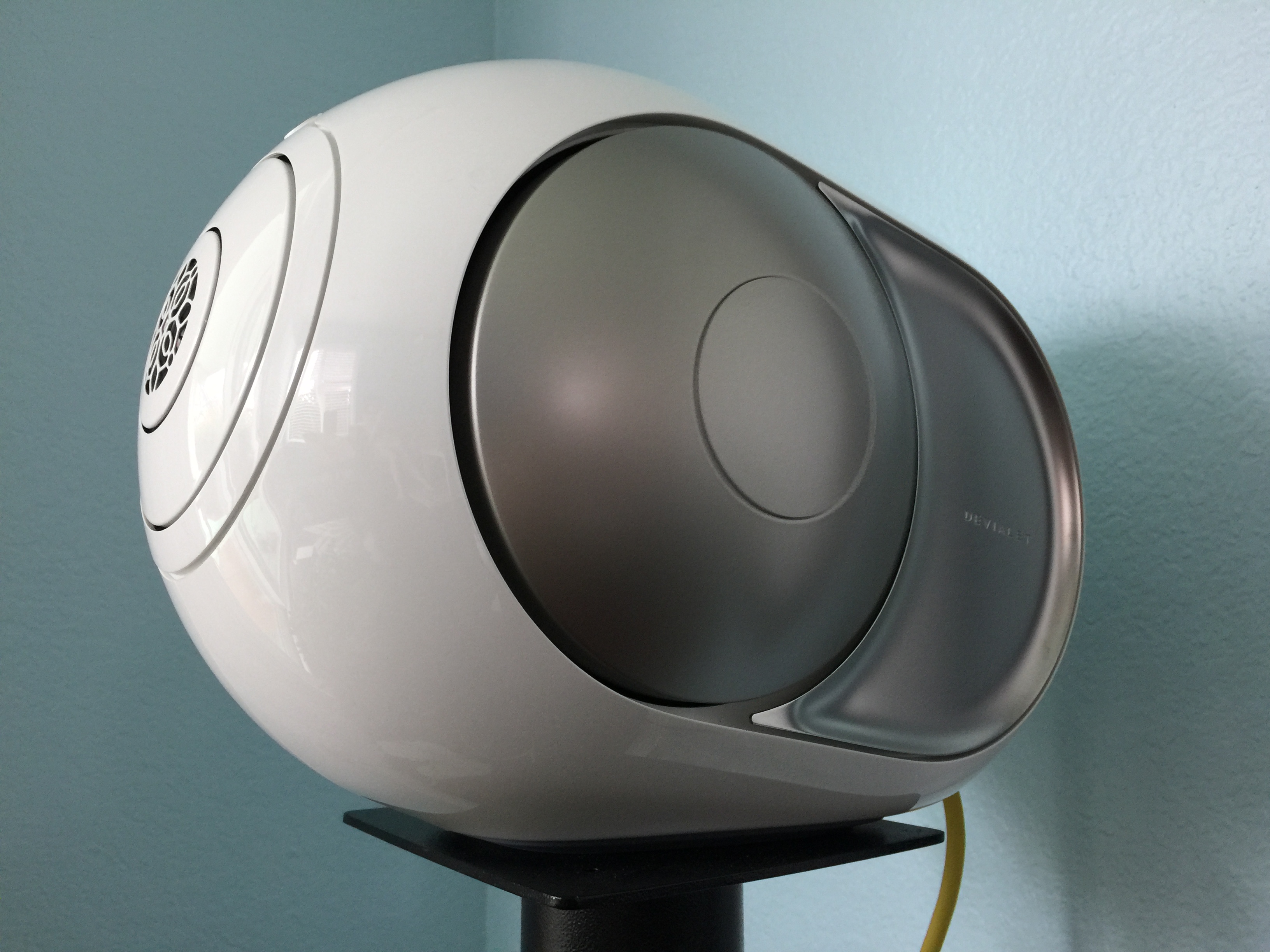Our Verdict
The Devialet Phantom is the most potent audio speaker available.
For
- Unbelievable bass
- Goes extremely loud
- Maintains composure at any volume
- Many ways to connect
Against
- Processing lag when not using optical
- No analog inputs
- No Dolby Digital or DTS decoding (yet)
- 2 Phantoms required for stereo
PC Gamer's got your back
Bulging eyes, gaping mouths, peers turning for double-takes, and sometimes even looks of confusion: That was our observation of facial reactions when testing Devialet’s Silver Phantoms in the office. Describing audio performance is difficult. Should I wax poetic about how something sounds? Words such as air, stage, warm, smooth, rich—they don’t really mean anything. So perhaps a good descriptor would instead be how people react when they hear it.
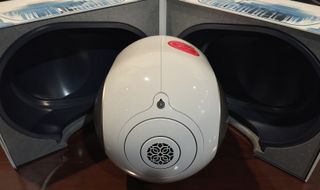
The Phantom is a speaker designed by French audio outlet Devialet. Haven’t heard of it? That’s OK, I hadn’t either. Unless you’re inside specific circles of the audiophile community, Devialet is a name few will recognize, but it’s revered for designing amplifiers for loudspeakers that go against conventional design principles.
About the size of two toasters, the Phantom looks anything but conventional— maybe more like an alien probe. But Devialet is adamant that despite its size, the Phantom can replace a hi-fi system costing $20,000 or more. And if you asked anyone who’s listened to the Phantoms, you might start believing so, too.
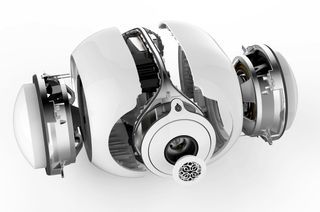
There are three main technologies in the Phantom: speaker active matching (SAM), analog-digital hybrid (ADH), and heart bass implosion (HBI).
Let’s start with SAM. Devialet measures movements of a speaker driver with lasers, then uses the information to mathematically map the driver. The result is speaker movement that’s precisely controlled, no matter what the volume is set to or what the audio content is. For Phantom, Devialet says it’s able to play at maximum volume without distortion and without loss of fidelity. In other words, the Phantom sounds awesome at all levels.
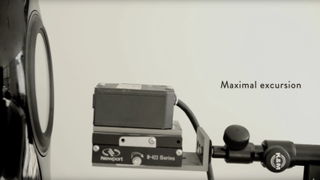
The onboard SAM controller monitors both the input waveform and compares that to the movement of the drivers at all times. In this way, the Phantom ensures that the drivers are doing exactly what's expected of them, nothing more, nothing less. SAM prevents the drivers from over excursion, while at the same time allowing them perform at their physical limits. Devialet says that the Phantom exhibits no perceivable distortion even at maximum levels and during my listening tests, I couldn't discern any distortion, even with heavy bass. SAM works.
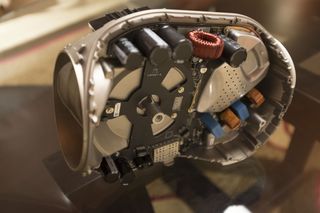
ADH is how the Phantom Silver delivers 3,000 watts of power. Using a combination of Class A and Class D amplifiers, the Phantom Silver can dish out 105 dB of sound pressure—enough to rock an entire nightclub. High-end speaker amps often employ Class A designs because the fidelity is high. The drawback is that Class A amps run hot due to inefficiency. This is where Class D amps come in—they’re highly efficient and powerful, but they lack fidelity. With ADH, Devialet combines both technologies to produce powerful—extremely loud—and clean audio.
Then we come to the final, and arguably most impressive technology: the HBI system. It’s the two fisheye drivers on either side of the Phantom, which are responsible for bass. And what glorious bass the Phantoms produce. Frequency response drills down to a mind-boggling 16Hz. In case you’re wondering, this is low—lower than most home theater subwoofers could ever dream of going. Humans can hear down to 20Hz, but the Phantom’s bass extension drills down to subsonic levels. Yes, you can feel the Phantoms.
“I’ve got a massive subwoofer with a 16-inch driver that can do that,” you say?
Great! Except, the Phantom is only 6 liters in volume—compare that with your monster 100-liter subwoofer. In case that didn't compute, the Phantom is small! If you’ve got a smaller sub or large floor-standing speakers, the Phantom will punch a hole through the floor and bury them.
This is where we get to the head-scratching reactions of listeners. Everyone, and we mean everyone, gawks in awe as the Phantom plays. They ask questions such as, “How is that thing making that kind of sound?” Or simply, “What the *@#$?!”
The Phantoms simply defy conventional speaker design principles. To deliver really low frequency extension at good volumes, a speaker cabinet needs to contain volume because lots of air mass needs to be moved. This is precisely why subwoofers that have very low frequency responses need to be designed large. Forget the subwoofer that came with your PC desktop; those aren’t what I’d consider real subwoofers.
Yet the unthinkable happens. Despite its small size, the Phantom can compete with subwoofers that consume many times its volume.
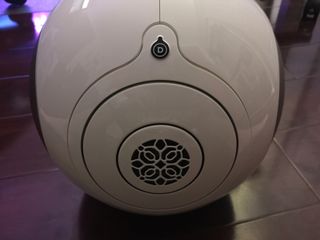
There are 4 main drivers on a Phantom: a front facing high frequency driver, a mid-range ring driver (that surrounds the high frequency driver), and two bass drivers on the side. All 4 drivers are independently isolated from each other.
Setup
Setup is different depending on whether you have one more more Phantoms. If you just have one, the process is easy: plug the power cable in, connect to the Phantom via Bluetooth, and run Devialet's Spark app. From there, you can connect online services such as Spotify, Tidal, and other radio services. You can use your PC to play music to the Phantom without a direct connection, but you'll need to install Spark. If you want to connect a Phantom directly up to something without going through Spark, you'll have to do so via optical Toslink.
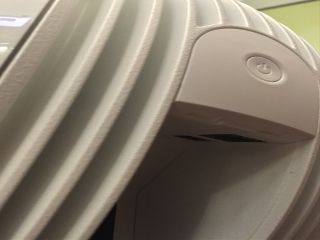
With two or more Phantoms, you have to buy Devialet's Dialog, which is a wireless hub that controls up to 24 Phantoms, and allow you to setup different spaces and speaker configurations. The Dialog also has an optical Toslink for direct input. Unfortunately, neither the Phantom or the Dialog has analog ins.
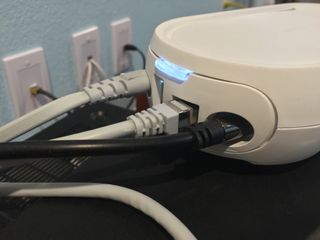
Once everything is plugged in, the setup process is fairly straightforward and is one of the most intimate events I have ever come across. Yes, I said intimate.
Once Spark opens, the Phantoms are detected and you're instructed to place your hands on them to confirm connection. As you touch the Phantoms, the side woofers slowly pulse and you hear an audible click, letting you know the unit you just embraced is now connected. Spark then allows you to set up a pair of Phantoms in stereo (if you have 2), or setup different Phantoms in different rooms.
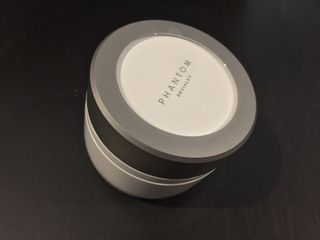
As an option, you can buy a physical remote from Devialet to control volume instead of using an app on your phone or PC. The remote pairs with the Phantoms in a similar fashion: walk up to any Phantom, and place the remote on its surface. A click is heard and the remote is paired. Smooth.
There are several ways to connect to the Phantoms: optical, Bluetooth, 1Gbit Ethernet, WiFi (2.4GHz and 5GHz), and power-line networking. Yes, the Phantoms can connect to a Dialog via power-line networking in case you're out of range of a wireless signal. It seems the engineers at Devialet thought things through.
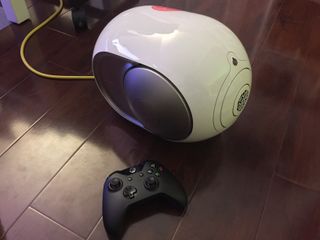
Listening
The Phantoms sound good with all genres of music, as well as movies. The real test is playing tracks with deep bass. More often than not, when speakers are cranked up, the bass will wreak havoc on the rest of the audio spectrum. Mids become unclear and highs are drowned out. Not so with the Phantoms. Here, SAM works so well that we perceived no dips in frequency response. Without using expletives—and believe me, I want to—the Phantoms are simply jaw-dropping. Bass is supremely powerful, tight, controlled, and deliberate. I simply have never heard of bass this caliber from a speaker system so small.
Here's the thing: I have a SVSound 20-35 subwoofer. Those who know SVSound, know that the company makes monstrous subwoofers for home theater and music. The Phantom competes with my SVS. Easily. In fact, my home water-heater sized subwoofer can only respond down to 20 Hz (18 Hz if tuned). The Phantom can go lower than that.
At this point, you might be calling BS, and I wouldn't blame you—I did too in the beginning. All I can say now is Devialet has some serious technology at work here—innovative technology.
I played back various tracks and movies, including the beginning scene of 007: Spectre, which if you've seen, know it packs some serious dynamic range. At no point in time did the Phantoms low frequencies overshadowed mids or highs. Every detail remained clear. In music listening, I did notice that the Phantoms weren't as strong in the upper-bass to lower mid frequencies (between 135 Hz to 220 Hz) but it wasn't detrimental to the overall experience.
What about stereo imaging? The problem is, you need two Phantoms to produce stereo. You can buy one Phantom, which still sounds phenomenal and has no issues lling large rooms, but it’ll only operate in summed-mono mode. To get true stereo, you’ll also need to purchase Devialet’s Dialog and the extra Phantom.
Thankfully, I have two.
Initially, I thought just one Phantom was incredible. But two is on another level. Stereo separation with two Phantoms is very well handled, and imaging was as good as you can hope for. Sounds and voices that are supposed to be in the center, sound like they're coming from the center. The Phantoms are exceptional at convincing you there are multiple speakers in front of you, clearly placing instruments, effects, and voices where there are no speakers.
For a true surround setup, Devialet doesn't yet support Dolby or DTS decoding. The company tells me that it's working on the feature, but did not give an estimated date. You could technically setup front, rears and center, but the process would be complicated and involve optical splitters and using an HDMI audio extractor.
So the Phantoms no doubt sound great with movies and music, but what about games?
Due to all the processing going on inside the Phantom, a slight lag is introduced. Initially, the Phantoms had quite a bit of lag but the company has reduced it down to a more manageable levels and for the most part is not apparent if you're directly connected via optical Toslink.
Games sound incredible. Explosions, gunshots, buildings collapsing, and other special effects sound true to life and room filling. Sometimes the sensation is just too much to take and I have to tone the volume down. Details remain clear, and imaging is excellent. If you want an end-game speaker system, the Phantoms are it.
There are two models: the vanilla Phantom, which is white, with 750 watts producing 99 dB, and the Silver Phantom. The Silver dishes out 3,000 watts at 105dB. Lest there be any doubt, 105dB is the legal limit for a club.
We’ve demoed the Phantoms to over 30 people now. All their reactions have been the same: mind-blown. The cost of this experience? $2,390 for one Silver Phantom, and double that for two, with an added $329 for the Dialog. Expensive? It depends on how you look at it. The audio performance from the Phantoms is right up there with fully decked out entertainment systems.
An instinctive reaction to Devialet's claims may be dismissive. But the company has garnered more than 50 awards in the last several years for its products. The technology in the Phantoms alone are covered by over 80 patents. Put it simply, there are no desktop speakers, monitors, or floor standing units that can touch the Phantoms given their size and performance ratio. Depending on how much you've invested in home theater equipment, the Phantoms can even be considered a bargain.
So, at just over $5,100, can the Phantoms replace our multi-thousand-dollar home theater system? For multi-channel movies? Not yet. But for everything else, nothing comes close.
The Devialet Phantom is the most potent audio speaker available.
